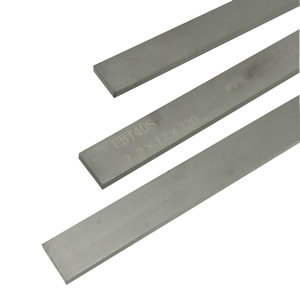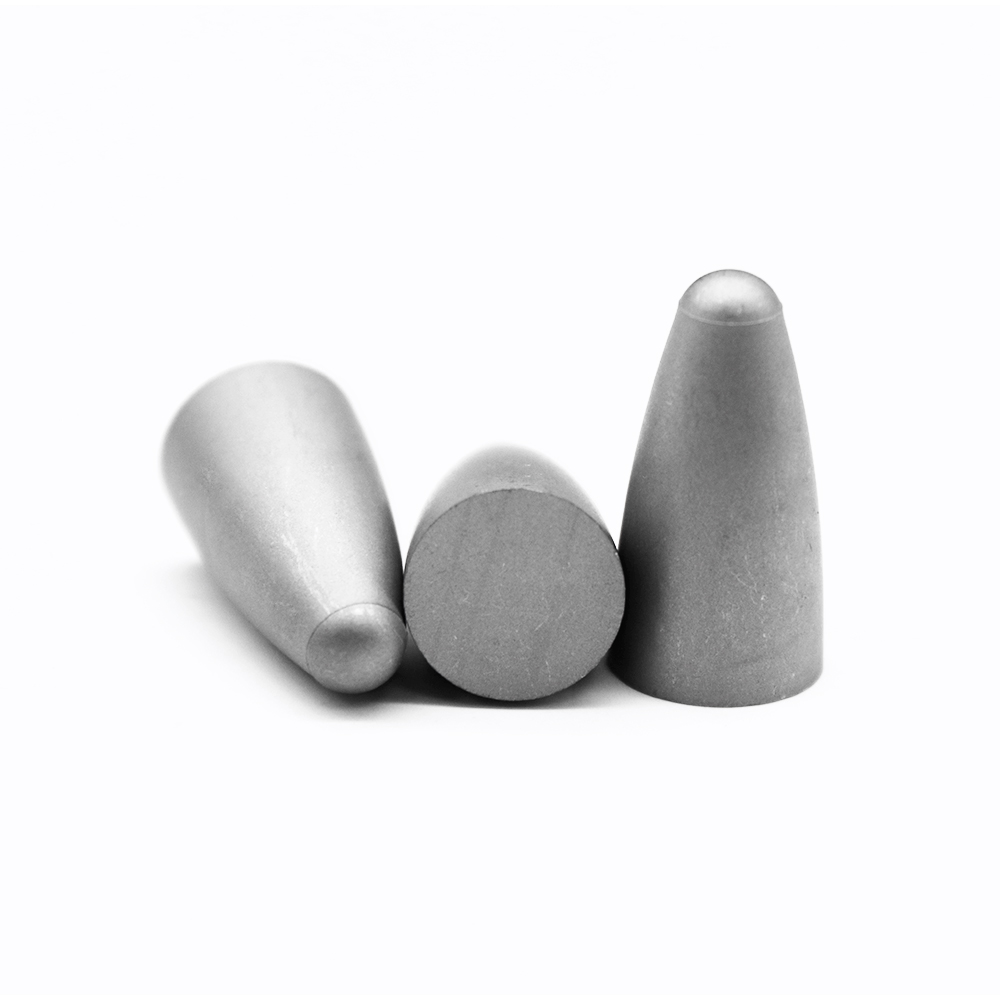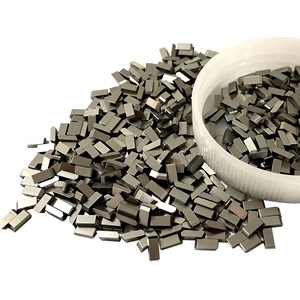ಕಾರ್ಬೈಡ್ ವರ್ಸಸ್ ಹೈ-ಸ್ಪೀಡ್ ಸ್ಟೀಲ್
ಕಾರ್ಬೈಡ್ ವರ್ಸಸ್ ಹೈ-ಸ್ಪೀಡ್ ಸ್ಟೀಲ್

ಕಾರ್ಬೈಡ್ ಮತ್ತು ಹೈ-ಸ್ಪೀಡ್ ಸ್ಟೀಲ್ (ಎಚ್ಎಸ್ಎಸ್) ಕತ್ತರಿಸುವ ಸಾಧನಗಳ ತಯಾರಿಕೆಯಲ್ಲಿ ಬಳಸುವ ಎರಡು ಪ್ರಮುಖ ವಸ್ತುಗಳು, ಪ್ರತಿಯೊಂದೂ ಅದರ ವಿಶಿಷ್ಟ ಗುಣಲಕ್ಷಣಗಳು ಮತ್ತು ಅನ್ವಯಿಕೆಗಳನ್ನು ಹೊಂದಿದೆ. ಕಾರ್ಬೈಡ್, ಸಾಮಾನ್ಯವಾಗಿ ಟಂಗ್ಸ್ಟನ್ ಕಾರ್ಬೈಡ್ನಿಂದ ಕೂಡಿದೆ, ಅದರ ಅಸಾಧಾರಣ ಗಡಸುತನ ಮತ್ತು ಧರಿಸುವ ಪ್ರತಿರೋಧಕ್ಕಾಗಿ ಆಚರಿಸಲಾಗುತ್ತದೆ, ಇದು ಹೆಚ್ಚಿನ ಕಾರ್ಯಕ್ಷಮತೆಯ ಯಂತ್ರಕ್ಕೆ ಸೂಕ್ತವಾಗಿದೆ. ಮತ್ತೊಂದೆಡೆ, ಹೈ-ಸ್ಪೀಡ್ ಸ್ಟೀಲ್ ಅದರ ಕಠಿಣತೆ ಮತ್ತು ಹೆಚ್ಚಿನ ತಾಪಮಾನವನ್ನು ತಡೆದುಕೊಳ್ಳುವ ಸಾಮರ್ಥ್ಯಕ್ಕೆ ಒಲವು ತೋರುತ್ತದೆ, ಇದು ವಿವಿಧ ಅನ್ವಯಿಕೆಗಳಲ್ಲಿ ಅಂಚುಗಳನ್ನು ಹೆಚ್ಚು ಉದ್ದವಾಗಿ ಕತ್ತರಿಸಲು ಅನುವು ಮಾಡಿಕೊಡುತ್ತದೆ. ಎರಡೂ ವಸ್ತುಗಳು ನಿರ್ದಿಷ್ಟ ಸಂದರ್ಭಗಳಲ್ಲಿ ಉತ್ಕೃಷ್ಟವಾಗಿದ್ದರೂ, ನಿರ್ದಿಷ್ಟ ಉದ್ಯೋಗಕ್ಕಾಗಿ ಸರಿಯಾದ ಸಾಧನವನ್ನು ಆಯ್ಕೆ ಮಾಡಲು ಅವುಗಳ ವ್ಯತ್ಯಾಸಗಳನ್ನು ಅರ್ಥಮಾಡಿಕೊಳ್ಳುವುದು ನಿರ್ಣಾಯಕವಾಗಿದೆ, ಯಂತ್ರ ಕಾರ್ಯಾಚರಣೆಗಳಲ್ಲಿ ದಕ್ಷತೆ ಮತ್ತು ನಿಖರತೆಯನ್ನು ಖಾತ್ರಿಗೊಳಿಸುತ್ತದೆ.
ಕಾರ್ಬೈಡ್ ಮತ್ತು ಹೈಸ್ಪೀಡ್ ಸ್ಟೀಲ್ ಅನ್ನು ಬೆಸುಗೆ ಹಾಕಲು ಸಾಧ್ಯವೇ?
ಕಾರ್ಬೈಡ್ ಮತ್ತು ಹೈಸ್ಪೀಡ್ ಸ್ಟೀಲ್ ನಡುವೆ ವೆಲ್ಡಿಂಗ್ ತಂತ್ರಗಳು ಗಮನಾರ್ಹವಾಗಿ ಭಿನ್ನವಾಗಿವೆ, ಪ್ರತಿಯೊಂದೂ ಅನನ್ಯ ಸವಾಲುಗಳನ್ನು ಪ್ರಸ್ತುತಪಡಿಸುತ್ತದೆ:
1. ಕಾರ್ಬೈಡ್ ವೆಲ್ಡಿಂಗ್:
ಕಾರ್ಬೈಡ್ ಪರಿಕರಗಳು, ವಿಶೇಷವಾಗಿ ಟಂಗ್ಸ್ಟನ್ ಕಾರ್ಬೈಡ್, ಅವುಗಳ ಗಡಸುತನ ಮತ್ತು ಬ್ರಿಟ್ನೆಸ್ನಿಂದಾಗಿ ಸಾಂಪ್ರದಾಯಿಕ ಅರ್ಥದಲ್ಲಿ ಬೆಸುಗೆ ಹಾಕುವುದಿಲ್ಲ. ಬದಲಾಗಿ, ಕಾರ್ಬೈಡ್ ಅನ್ನು ಸಾಮಾನ್ಯವಾಗಿ ಬ್ರೇಜ್ ಮಾಡಲಾಗುತ್ತದೆ, ಇದು ಹೆಚ್ಚಿನ ತಾಪಮಾನದಲ್ಲಿ ಫಿಲ್ಲರ್ ವಸ್ತುಗಳನ್ನು ಬಳಸಿಕೊಂಡು ಲೋಹದ ತಲಾಧಾರಕ್ಕೆ ಕಾರ್ಬೈಡ್ ಅನ್ನು ಸೇರುವ ಪ್ರಕ್ರಿಯೆ. ಪ್ರಮುಖ ಪರಿಗಣನೆಗಳು ಸೇರಿವೆ:
ಬ್ರೇಜಿಂಗ್ ತಂತ್ರಗಳು: ಕಾರ್ಬೈಡ್ನ ಸಮಗ್ರತೆಗೆ ಧಕ್ಕೆಯಾಗದಂತೆ ಬಲವಾದ ಬಂಧವನ್ನು ಖಚಿತಪಡಿಸಿಕೊಳ್ಳಲು ವಿಶೇಷ ಬ್ರೇಜಿಂಗ್ ತಂತ್ರಗಳನ್ನು ಬಳಸಿಕೊಳ್ಳಬೇಕು.
ತಾಪಮಾನ ನಿಯಂತ್ರಣ: ನಿಖರವಾದ ತಾಪಮಾನ ನಿಯಂತ್ರಣ ಅತ್ಯಗತ್ಯ, ಏಕೆಂದರೆ ಅತಿಯಾದ ಶಾಖವು ಕಾರ್ಬೈಡ್ನ ಬಿರುಕು ಅಥವಾ ಅವನತಿಗೆ ಕಾರಣವಾಗಬಹುದು.
ಮೇಲ್ಮೈ ತಯಾರಿಕೆ: ಬ್ರೇಜಿಂಗ್ ಪ್ರಕ್ರಿಯೆಯಲ್ಲಿ ಪರಿಣಾಮಕಾರಿ ಅಂಟಿಕೊಳ್ಳುವಿಕೆಯನ್ನು ಸಾಧಿಸಲು ಸರಿಯಾದ ಮೇಲ್ಮೈ ತಯಾರಿಕೆ ನಿರ್ಣಾಯಕವಾಗಿದೆ.
2. ಹೈ-ಸ್ಪೀಡ್ ಸ್ಟೀಲ್ ವೆಲ್ಡಿಂಗ್:
ಸಾಂಪ್ರದಾಯಿಕ ವೆಲ್ಡಿಂಗ್ ತಂತ್ರಗಳಿಗೆ ಹೈ-ಸ್ಪೀಡ್ ಸ್ಟೀಲ್ ಹೆಚ್ಚು ಅನುಕೂಲಕರವಾಗಿದೆ. ಗ್ಯಾಸ್ ಟಂಗ್ಸ್ಟನ್ ಆರ್ಕ್ ವೆಲ್ಡಿಂಗ್ (ಜಿಟಿಎಡಬ್ಲ್ಯೂ) ಅಥವಾ ಶೀಲ್ಡ್ಡ್ ಮೆಟಲ್ ಆರ್ಕ್ ವೆಲ್ಡಿಂಗ್ (ಎಸ್ಎಂಎಡಬ್ಲ್ಯೂ) ನಂತಹ ವಿಧಾನಗಳನ್ನು ಬಳಸಿಕೊಂಡು ಇದನ್ನು ಬೆಸುಗೆ ಹಾಕಬಹುದು. ವೆಲ್ಡಿಂಗ್ ಎಚ್ಎಸ್ಎಸ್ಗಾಗಿ ಪರಿಗಣನೆಗಳು ಸೇರಿವೆ:
ಪೂರ್ವಭಾವಿಯಾಗಿ ಕಾಯಿಸುವುದು: ವೆಲ್ಡಿಂಗ್ಗೆ ಮೊದಲು ಉಕ್ಕನ್ನು ಪೂರ್ವಭಾವಿಯಾಗಿ ಕಾಯಿಸುವುದರಿಂದ ಬಿರುಕು ಮಾಡುವ ಅಪಾಯವನ್ನು ಕಡಿಮೆ ಮಾಡಲು ಸಹಾಯ ಮಾಡುತ್ತದೆ.
ಫಿಲ್ಲರ್ ವಸ್ತು: ಹೊಂದಾಣಿಕೆ ಮತ್ತು ಯಾಂತ್ರಿಕ ಶಕ್ತಿಯನ್ನು ಖಚಿತಪಡಿಸಿಕೊಳ್ಳಲು ಸರಿಯಾದ ಫಿಲ್ಲರ್ ವಸ್ತುಗಳನ್ನು ಆರಿಸುವುದು ಮುಖ್ಯ.
ವೆಲ್ಡ್ ನಂತರದ ಚಿಕಿತ್ಸೆ: ವೆಲ್ಡ್ ನಂತರದ ಶಾಖ ಚಿಕಿತ್ಸೆಯು ಬೆಸುಗೆ ಹಾಕಿದ ಜಂಟಿಯ ಯಾಂತ್ರಿಕ ಗುಣಲಕ್ಷಣಗಳನ್ನು ಹೆಚ್ಚಿಸುತ್ತದೆ.
ಸಂಕ್ಷಿಪ್ತವಾಗಿ ಹೇಳುವುದಾದರೆ, ಕಾರ್ಬೈಡ್ ಅನ್ನು ಸಾಮಾನ್ಯವಾಗಿ ಬೆಸುಗೆ ಹಾಕುವ ಬದಲು ಬ್ರೇಜ್ ಮಾಡಲಾಗುತ್ತದೆಯಾದರೂ, ಸಾಂಪ್ರದಾಯಿಕ ತಂತ್ರಗಳನ್ನು ಬಳಸಿಕೊಂಡು ಹೆಚ್ಚಿನ ವೇಗದ ಉಕ್ಕನ್ನು ಬೆಸುಗೆ ಹಾಕಬಹುದು, ಪ್ರತಿಯೊಂದೂ ಬಲವಾದ, ವಿಶ್ವಾಸಾರ್ಹ ಕೀಲುಗಳನ್ನು ಖಚಿತಪಡಿಸಿಕೊಳ್ಳಲು ನಿರ್ದಿಷ್ಟ ಕೌಶಲ್ಯ ಮತ್ತು ವಿಧಾನಗಳ ಅಗತ್ಯವಿರುತ್ತದೆ.
ಸ್ಕ್ರ್ಯಾಚ್ ಪ್ರತಿರೋಧ: ಕಾರ್ಬೈಡ್ ವರ್ಸಸ್ ಹೈ-ಸ್ಪೀಡ್ ಸ್ಟೀಲ್
ಕಾರ್ಬೈಡ್ ಮತ್ತು ಹೈ-ಸ್ಪೀಡ್ ಸ್ಟೀಲ್ ಎರಡೂ ಗಮನಾರ್ಹ ಸ್ಕ್ರ್ಯಾಚ್ ಪ್ರತಿರೋಧವನ್ನು ಹೊಂದಿವೆ, ಆದರೆ ಅವುಗಳ ಕಾರ್ಯಕ್ಷಮತೆ ವಸ್ತು ಗುಣಲಕ್ಷಣಗಳ ಆಧಾರದ ಮೇಲೆ ಬದಲಾಗುತ್ತದೆ:
1. ಕಾರ್ಬೈಡ್:
ಕಾರ್ಬೈಡ್ ತನ್ನ ಅಸಾಧಾರಣ ಗಡಸುತನಕ್ಕೆ ಹೆಸರುವಾಸಿಯಾಗಿದೆ, MOHS ಪ್ರಮಾಣದಲ್ಲಿ 9 ರಷ್ಟಿದೆ. ಇದು ಹೆಚ್ಚು ಸ್ಕ್ರ್ಯಾಚ್-ನಿರೋಧಕವಾಗಿಸುತ್ತದೆ, ಅಪಘರ್ಷಕ ವಸ್ತುಗಳನ್ನು ಒಳಗೊಂಡ ಅಪ್ಲಿಕೇಶನ್ಗಳಿಗೆ ಸೂಕ್ತವಾಗಿದೆ. ಹೇಗಾದರೂ, ಕಾರ್ಬೈಡ್ ಗೀರುಗಳನ್ನು ಗಮನಾರ್ಹವಾಗಿ ವಿರೋಧಿಸಬಹುದಾದರೂ, ಇದು ಹೆಚ್ಚು ಸುಲಭವಾಗಿರುತ್ತದೆ, ಇದು ಅತಿಯಾದ ಒತ್ತಡದಲ್ಲಿ ಚಿಪ್ಪಿಂಗ್ ಮಾಡಲು ಕಾರಣವಾಗಬಹುದು.
2. ಹೈ-ಸ್ಪೀಡ್ ಸ್ಟೀಲ್:
ಹೈ-ಸ್ಪೀಡ್ ಸ್ಟೀಲ್ MOHS ಪ್ರಮಾಣದಲ್ಲಿ ಸುಮಾರು 6 ರಿಂದ 7.5 ರ ಗಡಸುತನದ ಮಟ್ಟವನ್ನು ಹೊಂದಿದೆ, ಇದು ಕಾರ್ಬೈಡ್ಗಿಂತ ಕಡಿಮೆ ಗೀರು-ನಿರೋಧಕವಾಗಿದೆ. ಆದಾಗ್ಯೂ, ಎಚ್ಎಸ್ಎಸ್ ಪರಿಕರಗಳು ಅವುಗಳ ಕಠಿಣತೆ ಮತ್ತು ಡಕ್ಟಿಲಿಟಿಗೆ ಹೆಸರುವಾಸಿಯಾಗಿದೆ, ಇದು ಪರಿಣಾಮವನ್ನು ತಡೆದುಕೊಳ್ಳಲು ಮತ್ತು ಹೆಚ್ಚಿನ ಒತ್ತಡದ ಸಂದರ್ಭಗಳಲ್ಲಿ ಉತ್ತಮವಾಗಿ ಧರಿಸಲು ಅನುವು ಮಾಡಿಕೊಡುತ್ತದೆ, ಇದು ಶಾಶ್ವತ ಹಾನಿಯ ಸಾಧ್ಯತೆಯನ್ನು ಕಡಿಮೆ ಮಾಡುತ್ತದೆ.
ಸಾಮಾನ್ಯವಾಗಿ, ಕಾರ್ಬೈಡ್ ಉತ್ತಮ ಸ್ಕ್ರ್ಯಾಚ್ ಪ್ರತಿರೋಧವನ್ನು ನೀಡುತ್ತದೆ, ಆದರೆ ಹೈ-ಸ್ಪೀಡ್ ಸ್ಟೀಲ್ ಪ್ರಭಾವದ ಅಡಿಯಲ್ಲಿ ಹೆಚ್ಚಿನ ಕಠಿಣತೆಯನ್ನು ನೀಡುತ್ತದೆ.
ಕ್ರ್ಯಾಕಿಂಗ್ ಪ್ರತಿರೋಧ:
1. ಕಾರ್ಬೈಡ್:
ಕಾರ್ಬೈಡ್ನ ಗಡಸುತನವು ಕತ್ತರಿಸಲು ಅನುಕೂಲಕರವಾಗಿದ್ದರೂ, ಹಠಾತ್ ಪರಿಣಾಮ ಅಥವಾ ಒತ್ತಡದ ಅಡಿಯಲ್ಲಿ ಬಿರುಕು ಬಿಡಲು ಹೆಚ್ಚು ಒಳಗಾಗುತ್ತದೆ. ಸರಿಯಾಗಿ ನಿರ್ವಹಿಸದಿದ್ದಲ್ಲಿ ಅದರ ಬ್ರಿಟ್ನೆಸ್ ದುರಂತದ ವೈಫಲ್ಯಕ್ಕೆ ಕಾರಣವಾಗಬಹುದು. ಆದ್ದರಿಂದ, ಸ್ಥಿರವಾದ, ಸ್ಥಿರವಾದ ಕತ್ತರಿಸುವ ಪರಿಸ್ಥಿತಿಗಳಿಗೆ ಕಾರ್ಬೈಡ್ ಉಪಕರಣಗಳು ಹೆಚ್ಚು ಸೂಕ್ತವಾಗಿವೆ.
2. ಹೈ-ಸ್ಪೀಡ್ ಸ್ಟೀಲ್:
ಹೈ-ಸ್ಪೀಡ್ ಸ್ಟೀಲ್, ಅದರ ಡಕ್ಟೈಲ್ ಸ್ವಭಾವದೊಂದಿಗೆ, ಕಾರ್ಬೈಡ್ಗೆ ಹೋಲಿಸಿದರೆ ಕ್ರ್ಯಾಕಿಂಗ್ಗೆ ಉತ್ತಮ ಪ್ರತಿರೋಧವನ್ನು ಪ್ರದರ್ಶಿಸುತ್ತದೆ. ಇದು ಪುನರಾವರ್ತಿತ ಒತ್ತಡವನ್ನು ಮತ್ತು ಚಕ್ರಗಳನ್ನು ಮುರಿಯದೆ ಲೋಡ್ ಮಾಡುತ್ತದೆ, ಇದು ಕ್ರಿಯಾತ್ಮಕ ಯಂತ್ರದ ಪರಿಸರದಲ್ಲಿ ವಿಶ್ವಾಸಾರ್ಹ ಆಯ್ಕೆಯಾಗಿದೆ, ಅಲ್ಲಿ ಪರಿಣಾಮಗಳು ಹೆಚ್ಚು ಸಾಮಾನ್ಯವಾಗಿದೆ.
ಸಂಕ್ಷಿಪ್ತವಾಗಿ ಹೇಳುವುದಾದರೆ, ಹೈ-ಸ್ಪೀಡ್ ಸ್ಟೀಲ್ ಸಾಮಾನ್ಯವಾಗಿ ಕಾರ್ಬೈಡ್ಗಿಂತ ಕ್ರ್ಯಾಕಿಂಗ್ಗೆ ಹೆಚ್ಚು ನಿರೋಧಕವಾಗಿದೆ ಏಕೆಂದರೆ ಅದರ ಅಂತರ್ಗತ ಕಠಿಣತೆ ಮತ್ತು ನಮ್ಯತೆಯಿಂದಾಗಿ.
ಕಾರ್ಬೈಡ್ ಮತ್ತು ಹೈಸ್ಪೀಡ್ ಸ್ಟೀಲ್ ಅನ್ನು ಹೇಗೆ ಪ್ರತ್ಯೇಕಿಸುವುದು?
1. ಗೋಚರತೆ:
ಕಾರ್ಬೈಡ್: ಸಾಮಾನ್ಯವಾಗಿ ಗಾ er ವಾದ, ಹೆಚ್ಚು ಲೋಹೀಯ ನೋಟವನ್ನು ಹೊಂದಿರುತ್ತದೆ ಮತ್ತು ಇದನ್ನು ಹೆಚ್ಚಾಗಿ ಒಳಸೇರಿಸುವಿಕೆಗಳು ಅಥವಾ ಸುಳಿವುಗಳಲ್ಲಿ ಬಳಸಲಾಗುತ್ತದೆ.
ಹೈ-ಸ್ಪೀಡ್ ಸ್ಟೀಲ್: ಸಾಮಾನ್ಯವಾಗಿ ಪ್ರಕಾಶಮಾನವಾಗಿ ಕಾಣಿಸಿಕೊಳ್ಳುತ್ತದೆ ಮತ್ತು ಟೂಲ್ ಬಾಡಿಗಳಲ್ಲಿ ಹೆಚ್ಚಾಗಿ ಕಂಡುಬರುತ್ತದೆ.
2. ತೂಕ:
ಕಾರ್ಬೈಡ್: ಹೈಸ್ಪೀಡ್ ಸ್ಟೀಲ್ಗೆ ಹೋಲಿಸಿದರೆ ದಟ್ಟವಾದ ಮತ್ತು ಭಾರವಾಗಿರುತ್ತದೆ.
ಹೈ-ಸ್ಪೀಡ್ ಸ್ಟೀಲ್: ಹಗುರವಾದ, ಟೂಲ್ ಅಸೆಂಬ್ಲಿಗಳಲ್ಲಿ ನಿರ್ವಹಿಸಲು ಸುಲಭವಾಗುತ್ತದೆ.
3. ಗಡಸುತನ:
ಕಾರ್ಬೈಡ್: ಅತ್ಯಂತ ಕಠಿಣ, ಇದು ಹೆವಿ ಡ್ಯೂಟಿ ಕತ್ತರಿಸುವಿಕೆಗೆ ಸೂಕ್ತವಾಗಿದೆ.
ಹೈ-ಸ್ಪೀಡ್ ಸ್ಟೀಲ್: ಕಠಿಣ, ಆದರೆ ಕಾರ್ಬೈಡ್ನಷ್ಟು ಕಠಿಣವಾಗಿಲ್ಲ, ಕೆಲವು ನಮ್ಯತೆಗೆ ಅನುವು ಮಾಡಿಕೊಡುತ್ತದೆ.
4. ಕಾಂತೀಯ ಗುಣಲಕ್ಷಣಗಳು:
ಕಾರ್ಬೈಡ್: ಸಾಮಾನ್ಯವಾಗಿ ಮ್ಯಾಗ್ನೆಟಿಕ್ ಅಲ್ಲದ.
ಹೈ-ಸ್ಪೀಡ್ ಸ್ಟೀಲ್: ಮ್ಯಾಗ್ನೆಟಿಕ್, ಇದು ಎರಡು ವಸ್ತುಗಳ ನಡುವೆ ವ್ಯತ್ಯಾಸವನ್ನು ಗುರುತಿಸಲು ಸಹಾಯ ಮಾಡುತ್ತದೆ.
5. ಸ್ಪಾರ್ಕ್ ಪರೀಕ್ಷೆ:
ಕಾರ್ಬೈಡ್: ಹೊಡೆದಾಗ ಪ್ರಕಾಶಮಾನವಾದ, ಸಣ್ಣ ಕಿಡಿಗಳನ್ನು ಉತ್ಪಾದಿಸುತ್ತದೆ.
ಹೈ-ಸ್ಪೀಡ್ ಸ್ಟೀಲ್: ದೀರ್ಘಕಾಲೀನ, ಹೆಚ್ಚು ತೀವ್ರವಾದ ಕಿಡಿಗಳನ್ನು ಸೃಷ್ಟಿಸುತ್ತದೆ.
ತೀರ್ಮಾನ
ಕೊನೆಯಲ್ಲಿ, ಕಾರ್ಬೈಡ್ ಮತ್ತು ಹೈ-ಸ್ಪೀಡ್ ಸ್ಟೀಲ್ ಎರಡೂ ಕತ್ತರಿಸುವ ಸಾಧನ ಉದ್ಯಮದಲ್ಲಿ ಪ್ರಮುಖ ವಸ್ತುಗಳಾಗಿದ್ದರೂ, ಅವು ತಮ್ಮ ಗುಣಲಕ್ಷಣಗಳ ಆಧಾರದ ಮೇಲೆ ವಿಭಿನ್ನ ಉದ್ದೇಶಗಳನ್ನು ಪೂರೈಸುತ್ತವೆ. ಕಾರ್ಬೈಡ್ ಗಡಸುತನ ಮತ್ತು ಸ್ಕ್ರಾಚ್ ಪ್ರತಿರೋಧದಲ್ಲಿ ಉತ್ತಮವಾಗಿದೆ, ಇದು ಅಪಘರ್ಷಕ ಕತ್ತರಿಸುವ ಅನ್ವಯಿಕೆಗಳಿಗೆ ಸೂಕ್ತವಾಗಿದೆ, ಆದರೆ ಇದು ಹೆಚ್ಚು ಸುಲಭವಾಗಿರುತ್ತದೆ. ಹೈ-ಸ್ಪೀಡ್ ಸ್ಟೀಲ್ ಕ್ರ್ಯಾಕಿಂಗ್ಗೆ ಉತ್ತಮ ಕಠಿಣತೆ ಮತ್ತು ಪ್ರತಿರೋಧವನ್ನು ನೀಡುತ್ತದೆ, ಇದು ಡೈನಾಮಿಕ್ ಮ್ಯಾಚಿಂಗ್ ಕಾರ್ಯಾಚರಣೆಗಳಿಗೆ ಸೂಕ್ತವಾಗಿದೆ.
ನಿರ್ದಿಷ್ಟ ಅಪ್ಲಿಕೇಶನ್ಗಳಿಗೆ ಸರಿಯಾದ ಸಾಧನವನ್ನು ಆಯ್ಕೆ ಮಾಡಲು, ಯಂತ್ರದ ಕಾರ್ಯಗಳಲ್ಲಿ ಅತ್ಯುತ್ತಮ ಕಾರ್ಯಕ್ಷಮತೆ ಮತ್ತು ಬಾಳಿಕೆ ಖಾತರಿಪಡಿಸುವುದು ಈ ವ್ಯತ್ಯಾಸಗಳನ್ನು ಅರ್ಥಮಾಡಿಕೊಳ್ಳುವುದು ಅತ್ಯಗತ್ಯ. ಅಂತಿಮವಾಗಿ, ಕಾರ್ಬೈಡ್ ಮತ್ತು ಹೈ-ಸ್ಪೀಡ್ ಸ್ಟೀಲ್ ನಡುವಿನ ಆಯ್ಕೆಯು ಉತ್ಪಾದನಾ ಪ್ರಕ್ರಿಯೆಗಳಲ್ಲಿ ಉತ್ತಮ ಫಲಿತಾಂಶಗಳನ್ನು ಸಾಧಿಸಲು ವರ್ಕ್ಪೀಸ್ನ ಸ್ವರೂಪ, ನಿರೀಕ್ಷಿತ ಉಡುಗೆ ಮತ್ತು ಆರ್ಥಿಕ ಪರಿಗಣನೆಗಳಂತಹ ಅಂಶಗಳನ್ನು ಪರಿಗಣಿಸಬೇಕು.





















